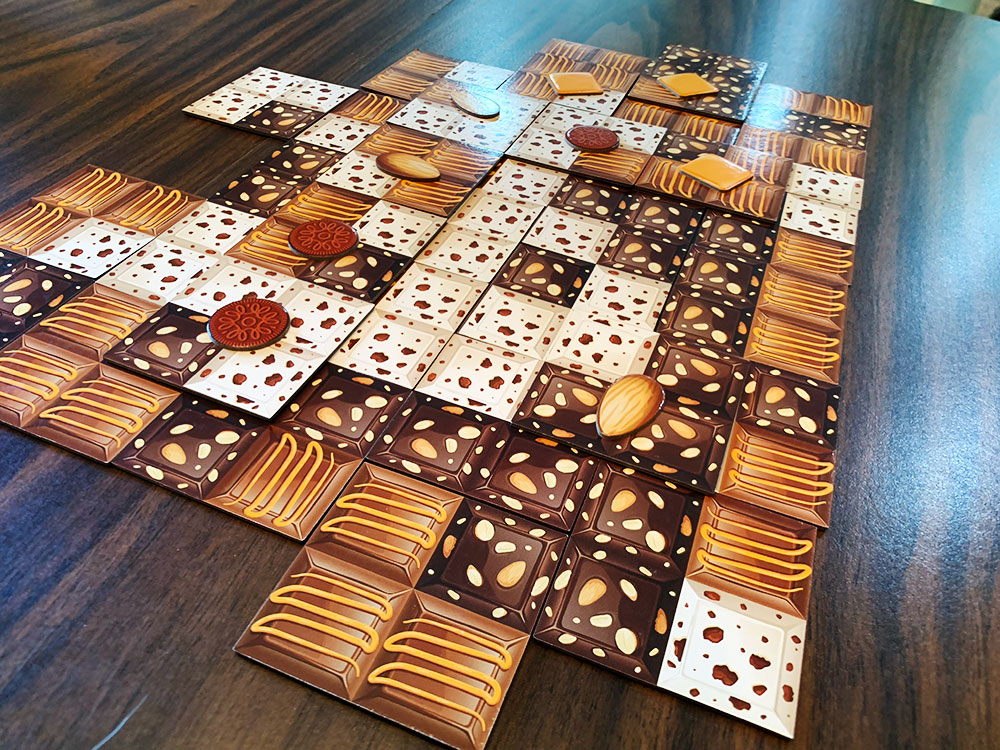 “Mom! Dad keeps putting almonds on my chocolate!” my tree nut-allergic son whined.
“Mom! Dad keeps putting almonds on my chocolate!” my tree nut-allergic son whined.
“We’re playing a game,” I protested.
“Then you can take him to the hospital if you think his allergy is a game,” she said as she walked into dining room where he and I were playing.
“No, really. It’s just a game,” I said pointing to the square cardboard tiles on the table.
“Then quit being mean to him,” she said as she rolled her eyes and he stuck his tongue out at me.
And people wonder why I like cooperative games so much…
Chocoly is a two to four player game that plays in about 15 minutes and won’t hurt kids with nut allergies (according to my playthroughs), but as the inverse-Bones McCoy: damnit [insert your name here]; I’m engineer, not a doctor.
Gameplay Overview:
For two- and three-player games of Chocoly, each player selects one of the three types of chocolate [caramel (brown), almond (dark), or cookies and cream (white)]. For a four player game, one flavor is neutral and players are on teams as in other two-player games such as Star Wars Rebellion, but with less combat, components, time investment, and siblings making out (Rebellion only).

Each turn you have a hand of three tiles that you choose to play one onto the slab of chocolate with a goal of building the largest continuous area of your flavor of chocolate. Tiles can be offset to other tiles but can’t overhang empty spaces. Additionally, throughout the game you can place a tile on top of existing tiles to change the board by using one of your flavor tokens. At the end of your turn, draw another tile to fill your hand back up to three.
Once per game, you can spend a cocoa bean token to discard your hand and draw anew. The old tiles go to the bottom of the stack of undrawn tiles so, unlike that Tom Petty song, they’ll be coming around again.
Play continues until all tiles have been placed, and then the owner(s) of the largest area win(s). If two areas are tied, the player with the most of their own flavor tokens touching their area wins. If that’s a tie, the player with the second largest area wins.

Game Experience:
Chocoly is a very simple game that can be played with just about anyone. It’s literally just: play a tile each turn, with the largest area at the end winning. The strategy comes from when you choose to play your tokens. Do you play them to extend your areas or block your opponents? Or maybe, you can do both. But with only three opportunities, it’s hard to know when to use them, so you risk ending the game without using them all or spending them too quickly and wishing you had one in reserve.
The ability to discard your hand of tiles once is nice, but those are coming back to your hand and there are times when your turns feel meaningless or, if you’re not careful, that all you did was assist your opponent. You can trade them in, but because they show up later, it all but guarantees that you’ll have at least one more dud (or marginally useful) turn. In a two- or four-player game, a third of the symbols are neutral fillers, which makes the three-player game a little more challenging tactically; without fillers you have to assume that seemingly disconnected areas can get connected using flavor tokens.

The blocking moves can seem mean, but I found that when a player chose to attach, (my almond adverse son, for example), it ended up putting too many confectionaries in his take-that-strategy basket, leaving him without a big enough area to win. The game is also quite short, so the limited number of times you can drizzle caramel all over their cookies and cream area like a savage takes the edge of any negative player interactions.
Chocoly is both a short filler and a gateway game, and it works well as both. I consider games as gateway-friendly when they have one main mechanic and gateway-plus when there’s two things players need to master. This is basically just one —play a tile— with tokens allowing you to break the rules a few times.
I’ve played at two and three players, so haven’t tried a four-player game yet, but it seems the latter plays like the two-player game using teams. I’m guessing that could work just fine, but it seems like a stretch to increase the player count,since as a short game, only playing half of it isn’t as impactful. I guess you could play this with six players if you really wanted to be rebellious (although I think you’d be short on tokens).
It’s a simple game, and there’s not a lot about it that’s offensive or unbalanced (except the second tiebreaker which just seems weird, although unlikely). But it also doesn’t stand out in a crowded genre of tile-placement games. It’s more open and interactive than Karuba but less engaging and complicated than Carcassonne or One Hundred Torii. I’d even describe it as a simpler game than Wild Kratts Endangered Wildlife.
Final Thoughts:
Like real chocolate, Chocoly is enjoyable but you can’t sustain yourself on it. This game is best as a filler to start or end a game night or with non-gamers as a way to ease them in hobby games. (But don’t expect to jump from this to an 18XX game immediately after this.) I’m inclined to keep this in my collection for those reasons, but I doubt this is going to replace anything or be a frequent go-to. While it’s fun, I have a hard time recommending it for most hobby gamers, because it doesn’t have the crossover appeal of other family games. But for young ones or non-gamers, it works well.
Source: Board Game Quest





